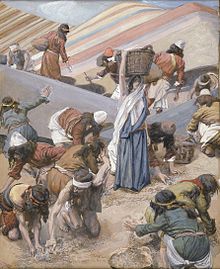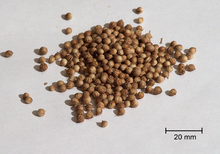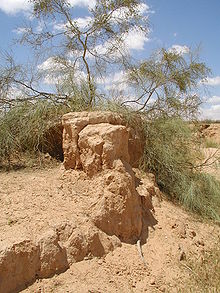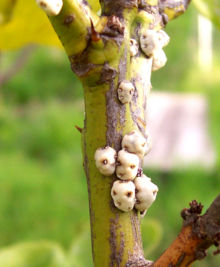- Manna
-
For other uses, see Manna (disambiguation).
 The Gathering of the Manna by James Tissot
The Gathering of the Manna by James Tissot
Manna (Hebrew: מָן) or Manna wa Salwa (Arabic: مَنّ, Kurdish: gezo, Persian: ترنجبين), sometimes or archaically spelled mana, is the name of an edible substance that God provided for the Israelites during their travels in the desert according to the Bible. It was said to be sweet to the taste, like honey. It is narrated in the hadith Sahih Muslim that the Muslim prophet Muhammad said "Truffles are part of the 'manna' which Allah, sent to the people of Israel through Musa (Moses), and its juice is a medicine for the eyes."
Contents
Description
Biblical description
 Manna is described as being comparable to Hoarfrost in size. Hoarfrost on grass lawn.
Manna is described as being comparable to Hoarfrost in size. Hoarfrost on grass lawn.
 According to the book of Exodus, manna is white, like Coriander seed.
According to the book of Exodus, manna is white, like Coriander seed.
In the description in the Book of Exodus, manna is described as being "a fine, flake-like thing" like the frost on the ground.[1] It is described in the Book of Numbers as arriving with the dew during the night;[2] Exodus adds that manna was comparable to hoarfrost in size,[1] similarly had to be collected before it was melted by the heat of the sun,[3] and was white like coriander seed in color.[4] Numbers describes it as having the appearance of bdellium,[5] adding that the Israelites ground it and pounded it into cakes, which were then baked, resulting in something that tasted like cakes baked with oil.[6] Exodus states that raw manna tasted like wafers that had been made with honey.[4] The Israelites were instructed to eat only the manna they had gathered for each day. Leftovers or manna stored up for the following day "bred worms and stank":[7] the exception being the day before Shabbat (Preparation Day), when twice the amount of manna was gathered, which did not spoil overnight; because, Exodus 16:23-24 [states] "This is what the LORD commanded: 'Tomorrow is to be a day of rest, a holy Sabbath to the LORD. So bake what you want to bake and boil what you want to boil. Save whatever is left and keep it until morning.' " 24 So they saved it until morning, as Moses commanded, and it did not stink or get maggots in it."
Potential discrepancies
Some form critics posit conflicting descriptions of manna as derived from different lore, with the description in Numbers being from the Jewish tradition, and the description in Exodus being from the later Priestly tradition.[8][9] The Babylonian Talmud states that the differences in description were due to the taste varying depending on who ate it, with it tasting like honey for small children, like bread for youths, and like oil for the elderly.[10] Similarly, classical rabbinical literature rectifies the question of whether manna came before or after dew, by holding that the manna was sandwiched between two layers of dew, one falling before the manna, and the other after.[11]
Identifying manna
 A tamarisk tree in the Levant desert.
A tamarisk tree in the Levant desert.
Some scholars have proposed that manna is cognate with the Egyptian term mennu, meaning "food".[12] At the turn of the twentieth century, Arabs of the Sinai Peninsula were selling resin from the tamarisk tree as man es-simma, roughly meaning "heavenly manna".[11] Tamarisk trees (particularly Tamarix gallica) were once comparatively extensive throughout the southern Sinai, and their resin is similar to wax, melts in the sun, is sweet and aromatic (like honey), and has a dirty-yellow color, fitting somewhat with the Biblical descriptions of manna.[13][14] However, this resin is mostly composed from sugar, so it would be unlikely to provide sufficient nutrition for a population to survive over long periods of time,[13] and it would be very difficult for it to have been compacted to become cakes.[14]
In the Biblical account, the name manna is said to derive from the question man hu, seemingly meaning "What is it?";[15] this is perhaps an Aramaic etymology, not a Hebrew one.[14] Man is possibly cognate with the Arabic term man, meaning plant lice, with man hu thus meaning "this is plant lice",[14] which fits one widespread modern identification of manna, the crystallized honeydew of certain scale insects.[14][16] In the environment of a desert, such honeydew rapidly dries due to evaporation of its water content, becoming a sticky solid, and later turning whitish, yellowish, or brownish;[14] honeydew of this form is considered a delicacy in the Middle East, and is a good source of carbohydrates.[16]
The other widespread identification is that manna is the thalli of certain lichens (particularly Lecanora esculenta);[13][16] this food source is often used as a substitute for maize in the Eurasian Steppe.[13] This material is light, often drifting in the wind, and has a yellow outer coat with a white inside, somewhat matching the Biblical description of manna; it does need additional drying, but is definitely not similar to honey in taste.[13]
A number of ethnomycologists such as R. Gordon Wasson, John Marco Allegro, and Terence McKenna, have suggested that most characteristics of manna are similar to that of Psilocybe cubensis mushrooms, notorious breeding grounds for insects, which decompose rapidly. This hypothesis, however, is confronted bluntly by the lack of documentation any sorts of hallucinations or other characteristic symptoms of ingestion of Psilocybin mushrooms, in, at least, connection with the Mana described in the Old Testament. These peculiar fungi naturally produce a number of molecules that resemble human neurochemicals, and first appear as small fibres (mycelia) that resemble hoarfrost. This speculation (also paralleled in Philip K. Dick's posthumously published The Transmigration of Timothy Archer) is supported in a wider cultural context when compared with the praise of Haoma in the Rigveda, Mexican praise of teonanácatl, the peyote sacrament of the Native American Church, and the Holy Ayahuasca used in the ritual of the União do Vegetal and Santo Daime.[17] The fact that manna is said to have risen 6 days a week, in the morning, and during the time of dew is another proponent to this theory.
Other minority identifications of manna are that it was a kosher species of locust,[18] or that it was the sap of certain succulent plants (such as those of the genus Alhagi, which have an appetite-suppressing effect).[19]
Origin
Manna is from heaven, according to the Bible,[20] but the various identifications of manna are naturalistic. In the Mishnah, manna is treated as a supernatural substance, created during the twilight of the sixth day of Creation,[21] and ensured to be clean, before it arrives, by the sweeping of the ground by a northern wind and subsequent rains.[22] According to classical rabbinical literature, manna was ground in a heavenly mill for the use of the righteous, but some of it was allocated to the wicked and left for them to grind themselves.[11]
Use and function
Until they reached Canaan, the Israelites are implied by some passages in the Bible to have eaten only manna during their desert sojourn,[23] despite the availability of milk and meat from the livestock with which they traveled, and the references to provisions of fine flour, oil, and meat, in parts of the journey's narrative.[11]
As a natural food substance, manna would produce waste products; but in classical rabbinical literature, as a supernatural substance, it was held that manna produced no waste, resulting in no defecation among the Israelites until several decades later, when the manna had ceased to fall.[24] Modern medical science suggests the lack of defecation over such a long period of time would cause severe bowel problems, especially when other food later began to be consumed again. Classical rabbinical writers say that the Israelites complained about the lack of defecation, and were concerned about potential bowel problems.[24]
Many Christian vegetarians say that God had originally intended man would not eat meat because plants cannot move and killing them would not be sinful: manna, a nonmeat substance, is used to support this theory.[25] Further, when the people complained and wished for quail, God gave it to them, and those who ate it grew sick after.[26]
Food was not manna's only use; one classical rabbinical source states that the fragrant odor of manna was used in an Israelite perfume.[11]
Gathering
Exodus says each day one omer of manna was gathered per family member,[27] and may imply this was regardless of how much effort was put into gathering it;[28] a midrash attributed to Rabbi Tanhuma remarks that although some were diligent enough to go into the fields to gather manna, others just lay down lazily and caught it with their outstretched hands.[29] The Talmud states that this factor was used to solve disputes about the ownership of slaves, since the number of omers of manna each household could gather would indicate how many people were legitimately part of the household;[30] the omers of manna for stolen slaves could only be gathered by legitimate owners, and therefore legitimate owners would have spare omers of manna.[30]
According to the Talmud, manna was found near the homes of those with strong belief in God, and far from the homes of those with doubts;[30] indeed, one classical midrash says that manna was intangible to Gentiles, as it would inevitably slip from their hands.[31] The Midrash Tanhuma holds that manna melted, formed liquid streams, was drunk by animals, flavored the animal flesh, and was thus indirectly eaten by Gentiles, this being the only manner that Gentiles could taste manna.[32] Despite these hints of uneven distribution, classical rabbinical literature expresses the view that manna fell in very large quantities each day. It holds that manna was layered out over 2,000 cubits square, between 50 and 60 cubits in height, enough to nourish the Israelites for 2,000 years[11] and to be seen from the palaces of every king in the East and West,[33] probably a metaphorical statement.
Shabbat
According to RIKI, Shabbat (Sabbath) was instituted the first week the manna appeared.[34] It states that twice as much manna as usual was available on the sixth mornings of the week, and none at all could be found on the seventh days;[35] although manna usually rotted and became maggot-infested after a single night,[7] manna which had been collected on the sixth day remained fresh until the second night.[36] Moses stated that the double portion of Preparation Day was to be consumed on Shabbat;[34] and that God instructed him no one should leave his place on Shabbat,[37] so that the people could rest during it.[38]
Form critics regard this part of the manna narrative to be spliced together from the Yahwist and Priestly traditions, with the Yahwist tradition emphasizing rest during Shabbat, while the Priestly tradition merely states that Shabbat exists, implying that the meaning of "Shabbat" was already known.[14][39] These critics regard this part of the manna narrative as an etiological supernature story designed to explain the origin of Shabbat observance, which in reality was probably pre-Mosaic.[14]
Duration of supply
Exodus states that the Israelites consumed the manna for 40 years, starting from the fifteenth day of the second month (Iyar 15),[40] but that it then ceased to appear once they had reached a settled land, and once they had reached the borders of Canaan (inhabited by the Canaanites).[41] Form critics attribute this variation to the view that each expression of the manna ceasing derives from different lore; the "settled land" is attributed to the Priestly tradition,[14][39] and "Canaan's borders" to the Yahwist tradition, or to a hypothetical later redaction to synchronize the account with that of the Book of Joshua,[14][39] which states that the manna ceased to appear on the day after the annual Passover festival (Nisan 14), when the Israelites had reached Gilgal.[42] The duration from Iyar 15 to Nisan 14, taken literally, is 40 years less one month.
There is also a disagreement among classical rabbinical writers as to when the manna ceased, particularly in regard to whether it remained after the death of Moses for a further 40 days, 70 days, or 14 years;[43] indeed, according to Joshua ben Levi, the manna ceased to appear at the moment that Moses died.[11]
Pot
Despite the eventual termination of the supply of manna, Exodus states that a small amount of it survived within an omer-sized pot or jar, which was kept facing the Testimony (possibly, adjacent to the Ark of the Covenant);[44] it indicates that Yahweh instructed this of Moses, who delegated it to Aaron.[45] The Epistle to the Hebrews states that the pot was stored inside the Ark.[46] Classical rabbinical sources believe the pot was of gold; some say it was only there for the generation following Moses, and others that it survived at least until the time of Jeremiah.[11] However, the First Book of Kings states that it was absent earlier than Jeremiah, during Solomon's reign in the tenth century B.C.[47] Form critics attribute the mention of the pot to the Priestly tradition, concluding that the pot existed in the early sixth century B.C.[39]
Later cultural references
By extension "manna" has been used to refer to any divine or spiritual nourishment.
For many years, Roman Catholics have annually collected a clear liquid from the tomb of Saint Nicholas;[48] legend attributes the pleasant perfume of this liquid as warding off evil, and it is sold to pilgrims as "the Manna of Saint Nicholas".[49] The liquid gradually seeps out of the tomb, but it is unclear whether it originates from the body within the tomb, or from the marble itself; since the town of Bari is a harbor, and the tomb is below sea level, there are several natural explanations for the manna fluid, including the transfer of seawater to the tomb by capillary action.[50]
In the seventeenth century, a woman marketed a clear, tasteless product as a cosmetic, "the Manna of Saint Nicholas of Bari". After the deaths of some 600 men, Italian authorities discovered that the alleged cosmetic was a preparation of arsenic, used by their wives.[51]
In a modern botanical context, manna is often used to refer to the secretions of various plants, especially of certain shrubs and trees, and in particular the sugars obtained by evaporating the sap of the Manna Ash, extracted by making small cuts in the bark.[52] The Manna Ash, native to southern Europe and southwest Asia, produces a blue-green sap, which has medicinal value as a mild laxative,[53] demulcent, and weak expectorant.[51]
The names of both the sugar mannose and its hydrogenated sugar alcohol, mannitol are derived from manna.[54]
Robert Nozick famously references "manna from heaven" in a thought experiment about distributive justice.[55]
Further reading
- Arthur, James (2000). Mushrooms and Mankind: The Impact of Mushrooms on Human Consciousness and Religion. Escondido, CA: Book Tree. ISBN 1585091510.
- Heinrich, Clark (2002). Magic Mushrooms in Religion and Alchemy. Rochester, VT: Park Street Press. ISBN 0892819979.
- Merkur, Dan (2000). The Mystery of Manna: The Psychedelic Sacrament of the Bible. Rochester, VT: Park Street Press. ISBN 0892817720.
- McKenna, Terence (1993). Food of the Gods: The Search for the Original Tree of Knowledge, A Radical History of Plants, Drugs, and Human Evolution. New York, NY: Bantam Books. ISBN 0553371304.
See also
- Ayahuasca, entheogenic sacrament of União do Vegetal
- Gaz (candy), a Manna nougat with chopped nuts from Isfahan, Iran
- Fly agaric, Amanita muscaria, potential correlation with Christmas tradition
- Peyote, entheogen and sacrament of Native American Church
- Psilocybe, "Flesh of God", teonanácatl
- Tuf Voyaging, a fictional account
- White Manna
- Ambrosia
Notes and references
- ^ a b Exodus 16:14
- ^ Numbers 11:9
- ^ Exodus 16:21
- ^ a b Exodus 16:31
- ^ Numbers 11:7
- ^ Numbers 11:8
- ^ a b Exodus 16:20
- ^ Peake's Commentary on the Bible
- ^ Jewish Encyclopedia, "Book of Exodus", "Book of Numbers"
- ^ Yoma 75b
- ^ a b c d e f g h Jewish Encyclopedia
- ^ George Ebers, Durch Gosen zum Sinai, p. 236
- ^ a b c d e Cheyne and Black, Encyclopedia Biblica
- ^ a b c d e f g h i j Peake's commentary on the Bible
- ^ Exodus 16:15
- ^ a b c Manna Sinai
- ^ Terence McKenna, Food of the Gods, New York, Harper Collins, p. 84
- ^ Pancakes or Locusts
- ^ Alhagi mannifera
- ^ Psalm 78:24-25, 105:40, John 6:31
- ^ Pirkei Avot 5:9
- ^ Mekhilta, Beshalah, Wayassa, 3
- ^ Numbers 21:5
- ^ a b Sifre (on Numbers) 87-89
- ^ Soler, Jean, The Semiotics of Food in the Bible
- ^ Numbers 11:4-11:35
- ^ Exodus 16:16
- ^ Exodus 16:17-18
- ^ Tanhuma, Beshalah 22
- ^ a b c Yoma 75a
- ^ Midrash Abkir (on Exodus) 258
- ^ Midrash Tanhuma
- ^ Yoma 76a
- ^ a b Exodus 16:23
- ^ Exodus 16:5, 16:22, 16:26-27
- ^ Exodus 16:24
- ^ Exodus 16:27-29
- ^ Exodus 16:30
- ^ a b c d Jewish Encyclopedia, "Book of Exodus"
- ^ Exodus 16:1-4
- ^ Exodus 16:35
- ^ Joshua 5:10-12
- ^ Jewish Encyclopedia, "Manna"
- ^ Exodus 16:34
- ^ Exodus 16:32-33
- ^ Hebrews 9:4
- ^ 1 Kings 8:9
- ^ Devotion and Use of the Manna of Saint Nicholas, St. Nicholas Center
- ^ Carroll, Rory, 2000-12-22, Bones of contention, The Guardian
- ^ Girling, Richard, 2004-12-12, Talking Point: Now do you believe in Santa Claus?, The Times
- ^ a b Manna, Time magazine, 1927-08-29
- ^ Rushforth, K., 1999, Trees of Britain and Europe, Collins, ISBN 0002200139
- ^ Grieve, Mrs. M., Ash, Manna
- ^ Cooley's Cyclopaedia of Practical Receipts, 6th ed. (1880)
- ^ http://www.iep.utm.edu/nozick/
External links
- Jewish Encyclopedia, Manna
- chabad.org, The Manna
- Catholic Encyclopedia, Manna
- Devotion and Use of the Manna of Saint Nicholas
- Lycaeum, Manna as a mushroom [psilocybe]
- Manna For Haiti
Ark of the Covenant topics People Kohanim • Kohen Gadol • Israelites • Levites • Bezalel • Tribe of Judah • Aholiab • Kohath • Tribe of Levi • Jeremiah • Joshua • Samuel • Solomon • Menelik I • Beta IsraelContents Locations Mount Sinai • Jericho • Jordan River • Holy of Holies • Kodesh Hakodashim • Ai • Shiloh • Gibeah • Gilgal • Eben-Ezer • Philistia • Beth Shemesh • Kiriath-Jearim • Temple Mount • Dome of the Rock • Well of Souls • Cathedral of Chartres • Tana Qirqos • Church of Our Lady Mary of ZionCategories:- Hebrew words and phrases
- Mythological substances
- Bible
- Breads
- Fungi
- Book of Exodus
- Book of Numbers
- Fictional foods
Wikimedia Foundation. 2010.




